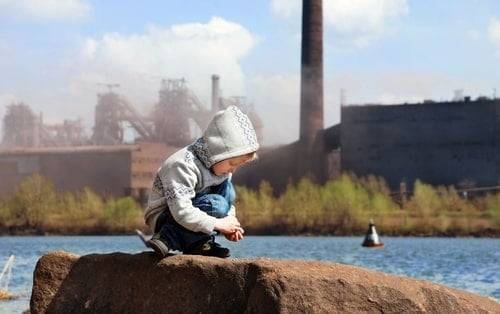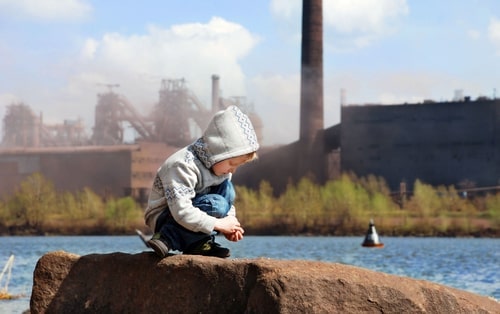The effects of air pollution on children

When young children are exposed to polluted air – including particulate matter (PM) – they don’t just suffer from respiratory problems. They are also more likely to develop chronic inflammation, and risky health conditions associated with inflammation. In addition, air pollution has been linked with adverse birth outcomes, accelerated cellular aging, and reductions in white and grey brain matter.
So it’s important for all of us – parents, teachers, citizens, voters – to keep track of the threat that polluted air poses. Here’s an overview of what we know about air pollution, and the effects of air pollution on babies and children.

Understanding air pollution: What are the major pollutants?
Air pollutants include a wide range of noxious substances, including
- nitrogen oxides (NO2, NO);
- carbon monoxide (CO);
- black or elemental carbon;
- ozone (O3);
- polycyclic aromatic hydrocarbons (PAH);
- sulfur dioxide (SO2);
- heavy metal toxins, like lead and cadmium;
- volatile organic compounds (VOC), including the “BTEX” chemicals — benzene, toluene, ethylbenzene and xylene; and
- particulate matter (PM2.5, PM10).
The last of these – particulate matter – refers to the tiny particles found in dust, dirt, soot, and smoke. These particles can be made up all sorts of things, and they may carry toxic “hitchhikers,” such as arsenic or lead (Schraufnagel et al 2019). The smallest particles – those 2.5 microns in diameter – are often abbreviated as “PM2.5”, and they among the most harmful components of air pollution.
What are the sources of this air pollution?
One of the most pervasive sources – found just about everywhere – is Traffic-Related Air Pollution, or “TRAP”. The combustion of fuel from motor vehicles fills the air with particulate matter made up of black carbon, toxic metals, and PAHs. Traffic also kicks up dust on the road, as well as particles shed by the friction of tires and breaks (Brumberg et al 2021).
Other sources of air pollution include coal-burning power plants, wood-burning stoves, animal agriculture (including emissions from manure), fracking, mineral dust (from both deserts and human industrial activity), and wildfires (Brumberg et al 2021; Urrutia-Pereira et al 2021).
How does air pollution affect children’s health?
Some of the effects are very intuitive and easy to imagine. When inhaled particles are very small – 2.5 microns or less in diameter – they can irritate the mucus membranes of the nasal cavity, triggering a runny nose and cough. In addition, these fine particles can make their way into the lungs – causing inflammation there. As a result, PM2.5 air pollution puts children at higher risk for developing respiratory illnesses, and researchers have observed this in populations around the world.
For example, to compare concentrations of particulate matter in the air, scientists typically take samples and then count micrograms per cubic meter (μg/m3). As per data collected in 2018, the Indian city of Delhi had the worst numbers for particulate matter with diameters ≤2.5 μm (PM2.5), averaging 113.5 μg/m3 (Rodríguez-Urregoa et al 2020). At the other end of the spectrum, cities in Switzerland typically average less than 5 μg/m3 (Grange et al 2021).
How much difference does it make – this variation in exposure to particulate matter? In one analysis, researchers found that for every 10 μg/m3 increase in annual average PM2.5 concentration, kids had a 12% higher risk of experiencing acute lower respiratory tract infections, which include pneumonia, acute bronchitis, whooping cough, and the flu (Mehta et al 2013).
Other studies have found links between PM2.5 concentrations, lung function, and asthma (Zhang, Ma et al 2022; Chen et al 2022). But this is only the beginning, because air pollution doesn’t just get into our airways and lungs. It’s possible that some particles – including “ultrafine” particles that are just 0.1 microns or less in diameter — can pass through lung tissue and into the blood stream (Basith et al 2022). It’s also possible that particles can make their way into the digestive tract as a result of getting swallowed.
By these means, particulate matter can affect much more than a child’s respiratory system. Scientists are still putting together the evidence, trying to understand the precise mechanisms. But it seems clear that particulate matter can contribute to inflammation in the lungs and digestive tract, and these instances of local inflammation can trigger the immune system to go into “overdrive” – releasing pro-inflammatory cytokines throughout the body. In this way, air pollution can impact many organs, including the heart and brain (Schraufnagel et al 2019; Ha 2020).
This likely explains why air pollution is linked with such a broad array of inflammation-related health conditions, including cardiovascular diseases and diabetes. In addition, pollutants may cause harm via other routes, including direct damage to the DNA.
Let’s take a closer look at some of the most-studied effects of air pollution on babies and children.
The effects of air pollution on birth outcomes
For decades, studies have tracked birth outcomes among pregnant women exposed to air pollution, and the overall trend is clear: Air pollution, like PM2.5 and sulfur dioxide, is linked with miscarriage and low birth weight (Nyadanu et al 2022; Lee 2021; Veber et al 2022).
How sizeable is the effect of air pollution on adverse birth incomes? For many infants, the effect may be small, but of course it depends on how polluted the air actually is. A few years ago, Saskia van der Zee and colleagues helped put this into perspective by comparing the risk of prenatal PM exposure to the risk of prenatal cigarette smoke exposure. The researchers calculated that for every 10 µg/m3 increase in PM2.5 concentration, the risk of preterm birth was heightened by an amount equivalent of having your mother smoke approximately three additional cigarettes per day (van der Zee et al 2016).
The effects of air pollution on cellular aging
When pregnant mothers are exposed to higher levels of air pollution, their babies’ blood may show signs of something called oxidative stress – the damaging effects of free radicals that tend to “age” our cells. In particular, newborns exposed to prenatal air pollution tend to have shorter telomeres – the molecular bumpers that cap our chromosomes and protect our DNA. When telomeres get attacked by free radicals, they lose some of their length, and this is considered a marker of premature cellular aging (Isaevska et al 2021).
Effects of air pollution on the cardiovascular system
Air pollution is linked with cardiovascular problems in adults, including hypertension, blood clots, and stroke (Qin et al 2022; Zhang, Wang et al 2022; Juneja Gandhi et al 2022; Wang et al 2022). What about kids? Studies indicate that long-term exposure to PM2.5 pollution is associated with elevated childhood blood pressure, and increased rates of hypertension (Kim et al 2020). In addition, researchers suspect that early exposure to PM2.5 and other forms of air pollution may set children up for adverse cardiovascular events (like blood clots and stroke) later in life (Kim et al 2020).
Air pollution and infant gut biome
We carry an ecosystem of microbes in our digestive tracts, and these gut flora have an impact on our health. For example, there are microbe species that appear to promote inflammation, and heighten our risk for obesity, insulin resistance, and diabetes. Others have beneficial effects, including a tendency to decrease inflammation.
So it’s interesting to note that air pollution can alter the composition of our gut flora – reducing some species, boosting others. It’s been documented in experiments on rodents, and clinical studies suggest that this happens in humans as well.
Most recently, researchers examined the gut flora of 103 healthy, 6-month-old babies, and found links with air pollution: Infants who had been exposed to higher levels of particulate matter hosted greater quantities of Dialister and Dorea, microbe species associated with systemic inflammation. In addition, high exposure to PM2.5 was linked with lower quantities of Phascolarctobacterium – a microbe that reduces inflammation (Bailey et al 2022).
What about neurological development? Does air pollution affect a child’s brain?
The blood-brain barrier helps protect the brain from contact with damaging molecules. But some air pollution particles are small enough to break through the barrier. Other, ultrafine particles (those with diameters not exceeding 0.1 microns) may reach the brain by going directly through the nose and into the olfactory nerve (Elder et al 2006). And air pollutants can cause trouble indirectly, as well – by causing inflammation in other parts of the body, like the lungs or digestive tract, and subsequently triggering a general immune response: chronic, systemic inflammation (Peeples 2020).
What are the consequences? That isn’t clear, not yet. Brain scan studies suggest that early life exposure to TRAP (traffic-related air pollution) is linked with reductions in both white and grey brain matter. In addition, some epidemiological studies have reported that early life air pollution is associated with cognitive, emotional, and behavior problems (Ha 2021). But not every study is in agreement, and the overall effect – when detected – is pretty weak. Future studies may reveal that the impact of air pollution on neurodevelopment may depend on many factors – including the precise timing of exposure, and other, biological characteristics of the child (Ha 2021).
References: The effects of air pollution on babies and children
Bailey MJ, Holzhausen EA, Morgan ZEM, Naik N, Shaffer JP, Liang D, Chang HH, Sarnat J, Sun S, Berger PK, Schmidt KA, Lurmann F, Goran MI, Alderete TL. 2022. Postnatal exposure to ambient air pollutants is associated with the composition of the infant gut microbiota at 6-months of age. Gut Microbes. 14(1):2105096.
Basith S, Manavalan B, Shin TH, Park CB, Lee WS, Kim J, Lee G. 2022. The Impact of Fine Particulate Matter 2.5 on the Cardiovascular System: A Review of the Invisible Killer. Nanomaterials (Basel). 12(15):2656
Brumberg HL, Karr CJ, and Council on environmental health. 2021. Ambient Air Pollution: Health Hazards to Children. Pediatrics. 147(6):e2021051484.
Cardenas-Iniguez C, Burnor E, Herting MM. 2022. Neurotoxicants, the Developing Brain, and Mental Health. Biol Psychiatry Glob Open Sci. 2(3):223-232.
Chen G, Zhou H, He G, Zhu S, Sun X, Ye Y, Chen H, Xiao J, Hu J, Zeng F, Yang P, Gao Y, He Z, Wang J, Cao G, Chen Y, Feng H, Ma W, Liu C, Liu T. 2022. Effect of early-life exposure to PM2.5 on childhood asthma/wheezing: a birth cohort study. Pediatr Allergy Immunol. 33(6).
Elder A, Gelein R, Silva V, Feikert T, Opanashuk L, Carter J, Potter R, Maynard A, Ito Y, Finkelstein J, Oberdörster G. 2006. Translocation of inhaled ultrafine manganese oxide particles to the central nervous system. Environ. Health Perspect. 114: 1172–1178.
Fadlyana E, Soemarko DS, Endaryanto A, Haryanto B, Darma A, Dewi DK, Chandra DN, Hartono B, Buftheim S, Wasito E, Sundjaya T, Basrowi RW. 2022. The Impact of Air Pollution on Gut Microbiota and Children’s Health: An Expert Consensus. Children (Basel). 9(6):765.
Grange SK, Fischer A, Zellweger C, Alastuey A, et al. 2021. Switzerland’s PM10 and PM2.5 environmental increments show the importance of non-exhaust emissions. Atmospheric Environment X 12:100145
Ha S. 2021. Air pollution and neurological development in children. Dev Med Child Neurol. 63(4):374-381.
Herting MM, Younan D, Campbell CE, Chen JC. 2019. Outdoor Air Pollution and Brain Structure and Function From Across Childhood to Young Adulthood: A Methodological Review of Brain MRI Studies. Front Public Health. 7:332.
Isaevska E, Moccia C, Asta F, Cibella F, Gagliardi L, Ronfani L, Rusconi F, Stazi MA, Richiardi L. 2021. Exposure to ambient air pollution in the first 1000 days of life and alterations in the DNA methylome and telomere length in children: A systematic review. Environ Res. 193:110504.
Kim JB, Prunicki M, Haddad F, Dant C, Sampath V, Patel R, Smith E, Akdis C, Balmes J, Snyder MP, Wu JC, Nadeau KC. 2020. Cumulative Lifetime Burden of Cardiovascular Disease From Early Exposure to Air Pollution. J Am Heart Assoc. 9(6):e014944.
Lee JT. 2021. Review of epidemiological studies on air pollution and health effects in children. Clin Exp Pediatr. 64(1):3-11.
Juneja Gandhi T, Garg PR, Kurian K, Bjurgert J, Sahariah SA, Mehra S, Vishwakarma G. 2022. Outdoor Physical Activity in an Air Polluted Environment and Its Effect on the Cardiovascular System-A Systematic Review. Int J Environ Res Public Health. 2022 Aug 24;19(17):10547.
Mehta S, Shin H, Burnett R, North T, Cohen AJ. 2013. Ambient particulate air pollution and acute lower respiratory infections: a systematic review and implications for estimating the global burden of disease. Air Qual Atmos Health. 6(1):69-83.
Nyadanu SD, Dunne J, Tessema GA, Mullins B, Kumi-Boateng B, Lee Bell M, Duko B, Pereira G. 2022. Prenatal exposure to ambient air pollution and adverse birth outcomes: An umbrella review of 36 systematic reviews and meta-analyses. Environ Pollut. 306:119465.
Peeples L. 2020. News Feature: How air pollution threatens brain health. Proc Natl Acad Sci U S A. 117(25):13856-13860.
Qin P, Luo X, Zeng Y, Zhang Y, Li Y, Wu Y, Han M, Qie R, Wu X, Liu D, Huang S, Zhao Y, Feng Y, Yang X, Hu F, Sun X, Hu D, Zhang M. 2021. Long-term association of ambient air pollution and hypertension in adults and in children: A systematic review and meta-analysis. Sci Total Environ. 796:148620.
Rodríguez-Urrego D, Rodríguez-Urrego L. 2020. Air quality during the COVID-19: PM2.5 analysis in the 50 most polluted capital cities in the world. Environ Pollut. 2020 Nov;266(Pt 1):115042.
Schraufnagel DE, Balmes JR, Cowl CT, De Matteis S, Jung SH, Mortimer K, Perez-Padilla R, Rice MB, Riojas-Rodriguez H, Sood A, Thurston GD, To T, Vanker A, Wuebbles DJ. 2019. Air Pollution and Noncommunicable Diseases: A Review by the Forum of International Respiratory Societies’ Environmental Committee, Part 1: The Damaging Effects of Air Pollution. Chest. 155(2):409-416.
Urrutia-Pereira M, Rizzo LV, Staffeld PL, Chong-Neto HJ, Viegi G, Solé D. 2021. Dust from the Sahara to the American Continent: Health impacts. Allergol Immunopathol (Madr). 49(4):187-194.
van der Zee SC, Fischer PH, Hoek G. 2016. Air pollution in perspective: Health risks of air pollution expressed in equivalent numbers of passively smoked cigarettes. Environ Res. 148:475-483.
Veber T, Dahal U, Lang K, Orru K, Orru H. 2022. Industrial Air Pollution Leads to Adverse Birth Outcomes: A Systematized Review of Different Exposure Metrics and Health Effects in Newborns. Public Health Rev. 43:1604775.
Wang K, Wang W, Lei L, Lan Y, Liu Q, Ren L, Wu S. 2022. Association between short-term exposure to ambient air pollution and biomarkers of coagulation: A systematic review and meta-analysis. Environ Res. 215(Pt 1):114210.
Yan M, Xu J, Li C, Guo P, Yang X, Tang NJ. 2021. Associations between ambient air pollutants and blood pressure among children and adolescents: A systemic review and meta-analysis. Sci Total Environ. 785:147279.
Zhang W, Ma R, Wang Y, Jiang N, Zhang Y, Li T. 2022. The relationship between particulate matter and lung function of children: A systematic review and meta-analysis. Environ Pollut. 309:119735.
Zhang J, Wang X, Yan M, Shan A, Wang C, Yang X, Tang N.
2022. Sex Differences in Cardiovascular Risk Associated With Long-Term PM2.5 Exposure: A Systematic Review and Meta-Analysis of Cohort Studies. Front Public Health. 10:802167.
Content of “The effects of air pollution on babies and children” last modified 9/2022
image of toddler crouching on a rock with smoke stacks in the background by Soloviova Liudmyla / shutterstock















